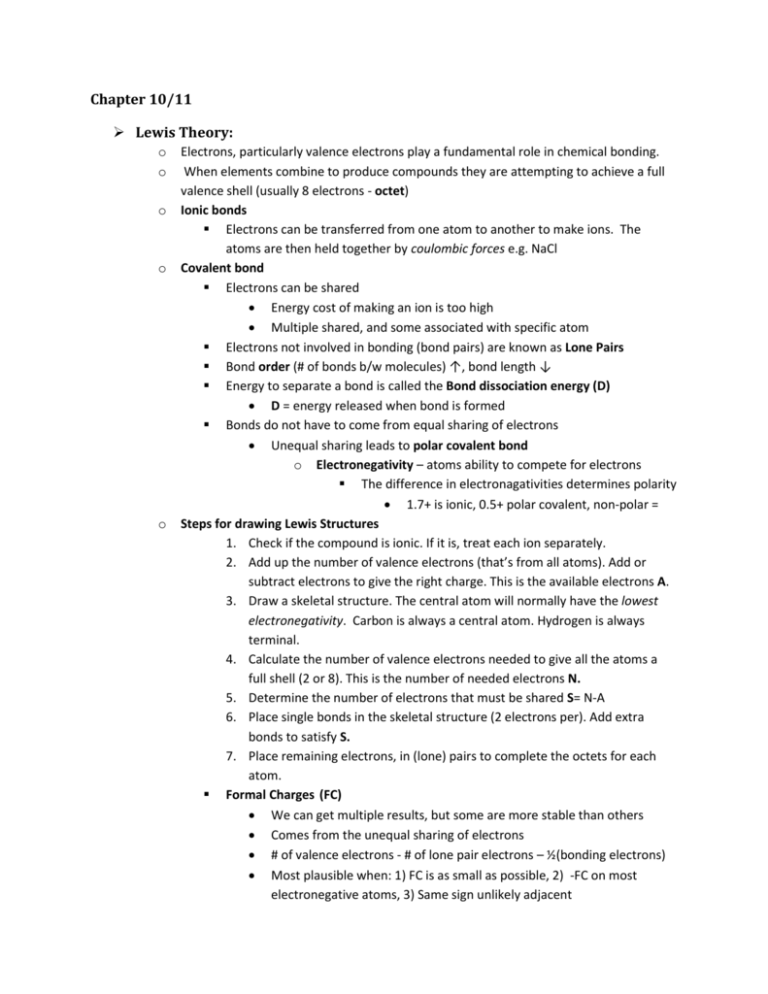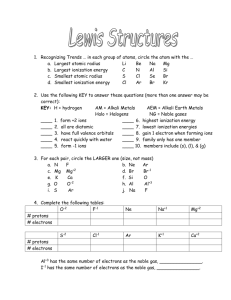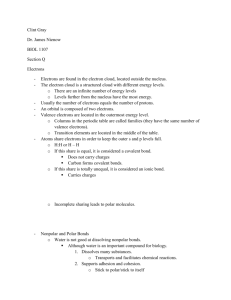chem_quiz_3_notes
advertisement

Chapter 10/11 Lewis Theory: o o o o o Electrons, particularly valence electrons play a fundamental role in chemical bonding. When elements combine to produce compounds they are attempting to achieve a full valence shell (usually 8 electrons - octet) Ionic bonds Electrons can be transferred from one atom to another to make ions. The atoms are then held together by coulombic forces e.g. NaCl Covalent bond Electrons can be shared Energy cost of making an ion is too high Multiple shared, and some associated with specific atom Electrons not involved in bonding (bond pairs) are known as Lone Pairs Bond order (# of bonds b/w molecules) ↑, bond length ↓ Energy to separate a bond is called the Bond dissociation energy (D) D = energy released when bond is formed Bonds do not have to come from equal sharing of electrons Unequal sharing leads to polar covalent bond o Electronegativity – atoms ability to compete for electrons The difference in electronagativities determines polarity 1.7+ is ionic, 0.5+ polar covalent, non-polar = Steps for drawing Lewis Structures 1. Check if the compound is ionic. If it is, treat each ion separately. 2. Add up the number of valence electrons (that’s from all atoms). Add or subtract electrons to give the right charge. This is the available electrons A. 3. Draw a skeletal structure. The central atom will normally have the lowest electronegativity. Carbon is always a central atom. Hydrogen is always terminal. 4. Calculate the number of valence electrons needed to give all the atoms a full shell (2 or 8). This is the number of needed electrons N. 5. Determine the number of electrons that must be shared S= N-A 6. Place single bonds in the skeletal structure (2 electrons per). Add extra bonds to satisfy S. 7. Place remaining electrons, in (lone) pairs to complete the octets for each atom. Formal Charges (FC) We can get multiple results, but some are more stable than others Comes from the unequal sharing of electrons # of valence electrons - # of lone pair electrons – ½(bonding electrons) Most plausible when: 1) FC is as small as possible, 2) -FC on most electronegative atoms, 3) Same sign unlikely adjacent Lee Allen’s Method qA = GA – NA - ∑ EN(A)/EN(A) + EN(B) x NAB GA - group number (the number of electrons in the atom) NA - Number of lone pair electrons on “A” NAB - is the number of bonding electrons between “A” and “B” Resonance E.g. ozone The theoretical single and double bonds are of equal length (they shouldn’t since they’re of different orders), which means they are actually resonance hybrids – structure has bonds b/w double and single Odd electron species e.g. NO (11 electrons) Use extra electron to minimize FC Incomplete Octets The need for Octet overrides min. FC rule e.g. BF3 forming double bond Expanded valence shells Can have more than 8 in valence shell to explain bonding w “d orbital” E.g. Sulphate SO4 – use 2 double bonds along with 2 single bonds (expanded to hold 12) to minimize FC – resonance forms VSEPR Theory: o Valence shell electron pair repulsion Electron pairs repel and assume orientation to minimize repulsion\ Repulsive forces Lone pair-lone pair>Lone pair-bond pair>bond pair-bond pair Valence bond theory Covalent bonding results from overlap of atomic orbitals As atoms move closer, orbitals may overlap High probability of finding electron between nuclei Overlap can only occur for 2 half-filled orbitals or one empty and one filled orbital We need molecules to maintain shape and costs energy to make e jump Orbitals in atom are different in bond become hybrid orbitals via hybridization o Orbitals are made to have the same shape and energy e.g. methane C to sp3 o Energy conserved since sp hybrids are intermediate in E When molecule is formed you release the bond energy. If this is greater than the “cost” then it is worthwhile o o o o # of hybrids is same as the # of valence electrons E.g. B hybridizes to sp2 and Be to sp Orbitals that overlap along axis are called sigma bonds σ Orbitals that overlap side-to-side are called pi bonds π Remaining orbitals with unpaired electrons after hybridization are part of π system Delocalized pi bonds are another explanation for resonance Chapter 12 o Van der Waal Forces Result from different strengths and interactions bw molecules Responsible for real gas behavior, condensation London or Dispersion forces Chance that electronic charges not uniformly distributed – instantaneous dipole Induced dipole results from interactions in neighboring molecules with instantaneous dipoles When these two dipoles attract, it is known as a London or dispersion force Strongest in elongated or high electron molecule Ability for charge separation is polarizability ↑London forces, ↑ Boiling point Dipole-Dipole Interactions Different electronegativities lead to permanent charge separation o Permanent dipole – molecules with have d-d interactions In addition to London Forces Interaction b/w polar molecules is higher than non-polar Dipoles can cancel eachother out t/f not all molecules have permanent In mixtures where only 1 of 2 molecules has a permanent dipole, the pd can induce a dipole to interact Hydrogen Bonding Only occurs for H bonded to F, O, or N Bonded to very highly electronegative atoms an form weak bonds with an atom from an adjacent molecule Properties of Liquids and Solids o Vaporization Some molecules have sufficient k energy to overcome intermolecular forces and escape into the gaseous state Enthalpy required is heat of vaporization ∆Hv. ∆Hv = Hvapor - Hliquid = -∆Hcondensation Molecules can escape from liquid to vapor, and gas can condense to liquid Leads to an equilibrium bw evaporation and condensation Constant partial pressure of vapor called vapour pressure (strong function of temperature) o Determined by getting into equilibrium and ideal gas law o ln(P2/P1) = -∆Hvap/R ((1/T2)– (1/T1)) o Boiling and Boiling Point Vaporization occurs and a bubble of vapour forms If Pvapor < Pexternal , the bubble will collapse, but if Pvapor ≥ Pexternal, the bubble will rise to the surface and escape This is boiling, and the temperature is boiling point When Pvapor = 1 atm, the temp. is the normal boiling point o Critical Point If the liquid is heated in a sealed container, the pressure will cont. rise The density of vapour will rise and = density of liquid Distinction bw liquid and vapour disappears – no meniscus This is the Critical point o Triple Point is where 3 phases exist at equilibrium Properties of Solids o Intermolecular forces large enough so molecules held in place o Melting Point Temperature at which enough energy is provided to overcome forces (solid melts) This is the melting or freezing point The enthalpy for this process if the heat of fusion ∆Hfusion = Hliquid - Hsolid Temperature remains constant while 2 phases present When freezing, super-cooling (“over-shoot”) occurs bc liquid needs something to crystalize on o Sublimation Direct passage from solid to vapor ∆Hsublimation = ∆Hfusion + ∆Hvap Intermolecular Forces o Weak compared to sigma and pi bonds bw atoms As molecules get bigger, molecules exist as gas, liquid, solid o Network covalent solids Diamond Carbon is tetrahedral, and each is bonded to 4 others Form tetrahedron structures Silicon carbide o Substitute Si for half Carbon atoms Both structures are very hard Melt/Sublime at very high T o Graphite Uses orbital setup sp2 +p P orbital is above and provides bonding bw planes (can migrate – good conductor) Bonding within layers is strong, but weak bw layers (layers glide, so good lubricant) Ionic Solids Made up of ions, diff charges provide bonding ↑attractive force, if ↑charge and ↓size Lattice energy Energy given off when gas phase ions come together to form one mole of a solid ionic compound Use to assess difficulty of breaking up ionic crystal Determined using Hess’ Law Interionic Forces o Ions have lattice energies so large that: do not readily detach themselves from the crystal and pass into the gas state solids do not sublime @ ordinary temp ↑Lattice energy, ↑melting point Reference Linear - AX2 Trigonal Planar – AX3, AX2E (bent) Tetrahedral – AX4, AX3E (trigonal pyramidal), AX2E2 (bent) Trigonal Bipyramidal – AX5, AX4E (seesaw), AX3E2 (T-shaped), AX2E3 (linear) Octahedral – AX6, AX5E (square pyramidal), AX4E2 (square-planar)





